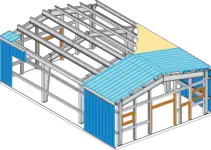ASD (allowable strength design) is one of the oldest system that is being used for the design of steel, beams, columns, roof slab, trusses etc… In this method design remains within the allowable stress. Hence, in ASD a factor of safety applies to the strength of the material. So that structure will remain within the allowable stress level.
Allowable stress for both concrete and steel (that is used in concrete as a reinforced concrete) can be easily calculated from the equations.
For Concrete
Where
is the compressive strength of concrete
For Steel
Where
is the yield strength of steel
Example
Statement
A singly reinforced concrete section has a compressive strength = 60Mpa, and yield strength of the reinforced steel = 420 MPa
Requirement
Design a bean using the allowable strength design method
Solution
As we have to use the allowable strength design method. Therefore, we will first find the allowable strength of concrete and steel by using formula 1 and 2.
- For Concrete
f’c = 60Mpa
Fa = 27 MPa
- For Steel
Fy = 420Mpa
Fa = 210 MPa
Interpretation
In allowable strength design, factor of safety applies to the strength of reinforced concrete. Therefore, from the above results, it is very clear that in ASD, structure will be designed within the reduced value of stress not in the actual strength of reinforced concrete.

do you have a fb fanpage
Excellent post. I used to be checking constantly this blog and I’m inspired! Very useful information specifically the final section 🙂 I care for such information a lot. I was seeking this particular info for a very lengthy time. Thanks and good luck.